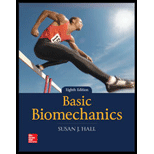
Concept explainers
a)
To determine: The torque produced at
a)
Answer to Problem 9AP
The torque created at
Explanation of Solution
Calculation:
Write an expression to find the torque at
Here,
Substitute 100 N for
Therefore, the torque created at
Therefore, the torque created at
b)
To determine: The torque produced at
b)
Answer to Problem 9AP
The torque created at
Explanation of Solution
Calculation:
Write an expression to find the torque at
Here,
Substitute 100 N for
Therefore, the torque created at
Therefore, the torque created at
c)
To determine: The torque produced at
c)
Answer to Problem 9AP
The torque created at
Explanation of Solution
Calculation:
Write an expression to find the torque at
Here,
Substitute 100 N for
Therefore, the torque created at
Therefore, the torque created at
d)
To determine: The torque produced at
d)
Answer to Problem 9AP
The torque created at
Explanation of Solution
Calculation:
Write an expression to find the torque at
Here,
Substitute 100 N for
Therefore, the torque created at
Therefore, the torque created at
e)
To determine: The torque produced at
e)
Answer to Problem 9AP
The torque created at
Explanation of Solution
Calculation:
Write an expression to find the torque at
Here,
Substitute 100 N for
Therefore, the torque created at
Therefore, the torque created at
Want to see more full solutions like this?
- Which of the following is (are) most likely to be decreased in a person undergoing physical therapy for a sports-related muscle injury? a. 1-RM load b. Active tension c. Critical frequency d. Minimum isometric load e. Passive tension f. Tetanic tension g. Vmaxarrow_forwardcontraction occurs as the length of the muscle increases. a. Concentric O b. Eccentric O c. Static O d. None of these In regard to the force-length relationship, it is true that: a. The muscle length at which maximal active force occurs is called optimal length b. Total force is equal to the sum of active and passive force C. All of these d. Beyond resting length, passive force increases from short to long muscle lengthsarrow_forwardTwo lifter's knees are of interest at a specific moment in their lifts. In both lifts, the knee extensor torque is 100 Nm, requiring quadriceps tendon/patella ligament forces of 1000 N (about 220 Ibs). Despite equivalent knee torques and quadriceps forces, patellofemoral joint forces are higher on the knees of lifter A. Briefly explain why. Edit View Insert Format Tools Table 12pt v Paragraph v BIUAarrow_forward
- 1 1 1 I A. On the box provided, label the components that make up the myofibril. Skeletal H wwwww 8 Car A. B. F. www. D. E.arrow_forwardWhen the most medial portion of the weight is traveling downwards, what type of muscular contraction is taking place at the wrist joint? must watch clip to answer https://www.youtube.com/watch?v=PvoauGkB31M a. Isometric b. Concentric c. Eccentric d. Isotonicarrow_forwardWhich of the following statements is FALSE regarding skeletal muscle contraction? O a. Calcium binds troponin specifically on a calcium binding site which then leads to tropomyosin movement O b. The action potential of a motor nerve is transmitted to a muscle fibre through the neuromuscular junction which is a fusion of nerve and muscle cell membranes O c. Fine motor movement/control is a result of recruiting smaller motor units O d. Calcium is pumped into storage soon after it is released to the cytoplasmarrow_forward
- Discuss the biomechanical factors that influence the ability of the thigh, leg, and foot to rotate about the hip joint during a sprinting stride. (Please answer give quickly)arrow_forwardAn isometric exercise is one in which the joint angle does not change during the application of muscle force. For instance, you can join your hands together, pushing down with one hand and pushing up with the other. In each arm, the muscles that provide the force are connected to the bones of the arm by tendons. If you increase the forces but keep the angles the same, the muscles will still contract. Explain how this is possible.arrow_forwardThe power stroke of muscle contraction occurs as the myosin head pivots toward its tail and the thin filament slides along the length of the thick filament. A. true B. falsearrow_forward
- Which region of the sarcomere does not change length between muscle relaxation and muscle contraction A. A band B. Z disc C. I Band D. H Zonearrow_forwardGeneration of Force 2 During concentric contractions, increasing the speed of contraction will a. increase the force produced b. have no effect on the force produced c. decrease the force produced DOO0arrow_forwardwhich of the following statement is true? a. Fast fibers have difficulty fatiguing b. Fast fibers have large glycogen reserves c. Fast fibers containe loosely packed myofibrils d. Fast fibers have a small diameterarrow_forward
 Human Physiology: From Cells to Systems (MindTap ...BiologyISBN:9781285866932Author:Lauralee SherwoodPublisher:Cengage Learning
Human Physiology: From Cells to Systems (MindTap ...BiologyISBN:9781285866932Author:Lauralee SherwoodPublisher:Cengage Learning
